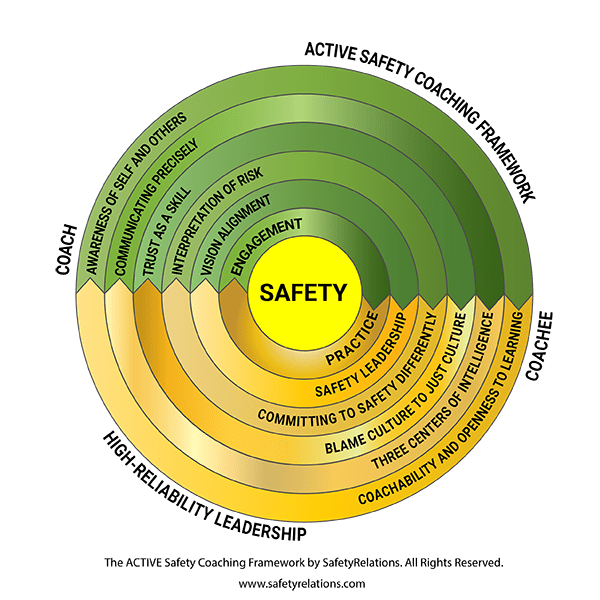Our ACTIVE Safety Coaching Framework
One of the key requirements for becoming a great safety coach is a robust coaching framework. Coaches typically follow one or more frameworks in the process of coaching and the effectiveness of those frameworks depends on the context in which they are applied.
We have developed the ACTIVE safety coaching framework with just one thing in mind, precision. Coaching is a structured conversation or a series of conversations that helps one see safety differently. Many safety meetings don’t produce the desired outcomes and are often seen as a waste of time. In such situations, our ACTIVE safety coaching framework is an excellent method to generate breakthroughs in safety performance because it addresses the root causes of imprecision in conversations. Let’s briefly look at each of the steps in this model.

Here are the key elements in our ACTIVE Safety Coaching Framework.
Awareness
Coaching begins by identifying to what degree the coachee is coachable. This is determined by several factors including self-awareness and the coachee’s barriers to learning. Working with a coachee who lacks commitment or one who does not trust their coach will not produce useful outcomes. As a safety coach, you need to build trust quickly and distinguish the behaviors of a committed coachee.
Communication
It is not unusual that traditional coaching ends up in circular conversations that do not produce results. This is the challenge with coaching models based solely on talking. The ACTIVE framework includes an understanding of the mechanics of language and emotions which gives you the tools to communicate more effectively.
Trust
Trust is a key element in a coaching relationship and is essential to shift organizations away from a blame culture. Many coaches assume that trust will “just happen” without considering that trust is an emotion, competence, and a risk-assessment tool. The ACTIVE framework includes specific steps that teach safety coaches to develop, maintain and repair trust and to coach non-judgmentally.
Interpretation
Since each of us is a unique observer, it is natural that your coachee may have a different assessment of risk than you, their coach. Through the process of coaching, you will develop a shared interpretation of risk which results in the coachee committing to shift both their understanding and behavior.
Vision
To be effective, your coaching has to be aligned to your company’s vision for safety and what is expected from the coachee to support that vision.
Engagement
Once the coachee has this new awareness and commitment, the final step is to bring it into action through practice. The coach will monitor the coachee’s progress during this phase. The goal is that, through practice, the new actions become habitual. If that is not happening, the coaching process can continue to discover what barriers are hindering the coachee.


